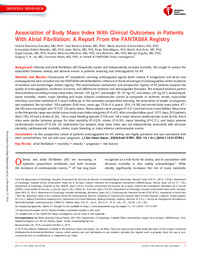Título :
Association of Body Mass Index With Clinical Outcomes in Patients With Atrial Fibrillation: A Report From the FANTASIIA Registry |
Autor :
Bertomeu-González, Vicente 
Moreno Arribas, José
Esteve-Pastor, María Asunción 
Rabadán-Martín, Inmaculada 
Muñiz, Javier 
Raña-Míguez, Paula
Ruíz-Ortíz, Martín
Cequier, Ángel 
BERTOMEU MARTINEZ, VICENTE 
Badimón, Lina
Anguita, Manuel
Lip, Gregory Y.H.
Manín, Francisco
FANTASIIA Study, Investigators |
Editor :
American Heart Association |
Departamento:
Departamentos de la UMH::Medicina Clínica |
Fecha de publicación:
2020-01-07 |
URI :
https://hdl.handle.net/11000/37863 |
Resumen :
Background Obesity and atrial fibrillation (AF) frequently coexist and independently increase mortality. We sought to assess the association between obesity and adverse events in patients receiving oral anticoagulants for AF. Methods and Results Consecutive AF outpatients receiving anticoagulant agents (both vitamin K antagonists and direct oral anticoagulants) were recruited into the FANTASIIA (Atrial fibrillation: influence of the level and type of anticoagulation on the incidence of ischemic and hemorrhagic stroke) registry. This observational, multicenter, and prospective registry of AF patients analyzes the quality of anticoagulation, incidence of events, and differences between oral anticoagulant therapies. We analyzed baseline patient characteristics according to body mass index, normal: <25 kg/m2, overweight: 25-30 kg/m2, and obese: ≥30 kg/m2), assessing all-cause mortality, stroke, major bleeding and major adverse cardiovascular events (a composite of ischemic stroke, myocardial infarction, and total mortality) at 3 years' follow-up. In this secondary prespecified substudy, the association of weight on prognosis was evaluated. We recruited 1956 patients (56% men, mean age 73.8±9.4 years): 358 (18.3%) had normal body mass index, 871 (44.5%) were overweight, and 727 (37.2%) were obese. Obese patients were younger (P<0.01) and had more comorbidities. Mean time in the therapeutic range was similar across body mass index categories (P=0.42). After a median follow-up of 1070 days, 255 patients died (13%), 45 had a stroke (2.3%), 146 a major bleeding episode (7.5%) and 168 a major adverse cardiovascular event (8.6%). Event rates were similar between groups for total mortality (P=0.29), stroke (P=0.90), major bleeding (P=0.31), and major adverse cardiovascular events (P=0.24). On multivariate Cox analysis, body mass index was not independently associated with all-cause mortality, cardiovascular mortality, stroke, major bleeding, or major adverse cardiovascular events. Conclusions In this prospective cohort of patients anticoagulated for AF, obesity was highly prevalent and was associated with more comorbidities, but not with poor prognosis.
|
Palabras clave/Materias:
atrial fibrillation
mortality
obesity
prognosis
risk factors |
Tipo de documento :
info:eu-repo/semantics/article |
Derechos de acceso:
info:eu-repo/semantics/openAccess
Attribution-NonCommercial-NoDerivatives 4.0 Internacional |
DOI :
10.1161/JAHA.119.013789 |
Publicado en:
J Am Heart Assoc . 2020 Jan 7;9(1):e01378 |
Aparece en las colecciones:
Artículos Medicina Clínica
|

 La licencia se describe como: Atribución-NonComercial-NoDerivada 4.0 Internacional.
La licencia se describe como: Atribución-NonComercial-NoDerivada 4.0 Internacional.
.png)